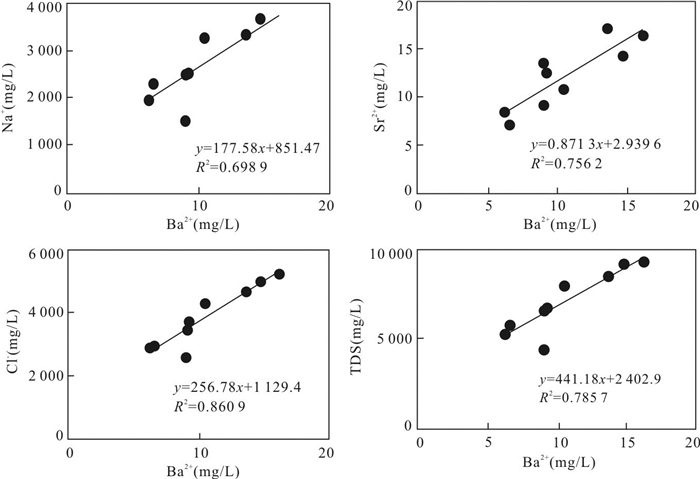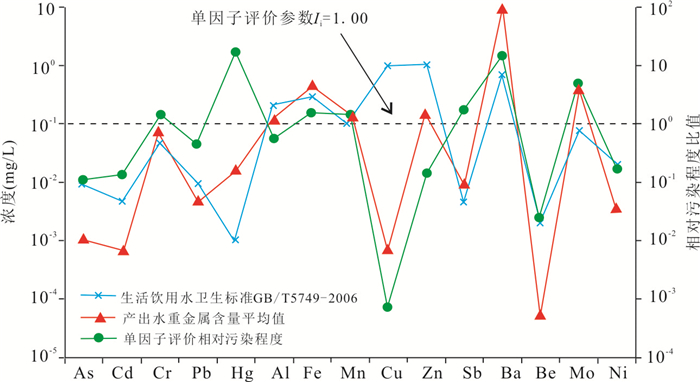Pollution Characteristics of Toxic and Harmful Elements and Its Environmental Impact in Water Co-Produced from Coalbed Methane Wells in the CBM Development Block in Western Guizhou
-
摘要: 由于含煤地层不同程度地富集氟、砷、镉、铬、汞和锑等多种有毒有害元素,煤层气开发过程中的大量产出水会对表生生态环境构成严重威胁.对贵州西部某煤层气开发区块产出水的水化学特征进行了系统研究,结果表明:与地下水质量标准(GB/T 14848-2017)Ⅲ类水质相比,研究区煤层气产出水中Ba和Hg严重超标,平均含量分别达到10 621.6 μg/L和16.5 μg/L.较强的硫酸盐还原作用导致地层水中硫酸盐被耗尽,含Ba碳酸盐矿物的溶解进而造成产出水表现出明显的Ba异常.Hg主要来源于含煤地层中的硫化物,而硫化物和碳酸盐矿物的溶解是Cr、Mo、Cd和Sb四种元素的主要来源;较高浓度的Mo与离子交换反应有关,并可能以铁锰氧化物和氢氧化物、硫代钼酸盐和钼的金属硫化物等形式存在;Al的氢氧化物吸附态是产出水中Cr、Mo、Mn、Cd、Sb、Cd、Cu、Pb和Ba的主要赋存形态;Ni主要来源于煤有机质的矿化.水质评价结果显示,研究区煤层气产出水的污染状况极为严重;其中,Hg在SH9煤层气井中超标27倍,而Ba在SH8煤层气井中超标23倍.Abstract: Coal seams are often enriched in various toxic and harmful elements such as F, As, Cd, Cr, Ni, Pb, Hg and Sb, so the ecosystem might be faced with serious environmental threats when the co-produced water is brought to the surface in the production of coalbed methane (CBM). In this paper, we present a systematic water chemistry study of co-produced water from Songhe coalbed methane development block in western Guizhou Province. The results show that, compared to Class Ⅲ of Groundwater Quality Standard (GB/T 14848-2017), Ba and Hg in co-produced water in the study area exceeded the standard seriously, and the average concentrations were 10 621.6 μg/L and 16.5 μg/L, respectively. The Ba anomaly in co-produced water was attributed to the dissolution of Ba-bearing carbonates and the depletion of sulfate induced by sulfate reduction, and Hg was from sulfide minerals. The sources for Cr, Mo, Cd and Sb were sulfides and carbonates in coal seams. The high content of Mo is associated with ion exchange reactions under high salinity, and molybdate and metallic sulfides are the main forms for Mo. Under weak alkaline conditions, the hydroxide adsorption state of Al is the main occurrence form of Cr, Mo, Mn, Cd, Sb, Cd, Cu, Pb and Ba in the co-produced water. The sources of Ni were obviously different from those of other elements, and it most likely came from the mineralization of coal organic matters. The results of water quality evaluation showed that the pollution of the water coproduced from coalbed methane wells in the study area is very serious, which is mainly due to the serious overstandard of Hg and Ba. In SH9, mercury is 27 times the legal limits and that is 23 times for barium in SH8.
-
表 1 研究区煤层气产出水重金属含量
Table 1. The trace elements contents in coalbed methane co-produced water in the study area
采样点 pH Eh As
(μg/L)Cd
(μg/L)Cr
(μg/L)Pb
(μg/L)Hg
(μg/L)Al
(μg/L)Fe
(μg/L)Mn
(μg/L)Cu
(μg/L)Zn
(μg/L)Sb
(μg/L)Ba
(μg/L)Be
(μg/L)Mo
(μg/L)Ni
(μg/L)SH1 7.13 -85 0.5 0.0 0.3 1.5 5.4 32.1 2 831.9 244.6 0.4 33.3 8.3 9 068.3 0.1 9.2 0.6 SH2 7.71 -133 0.7 0.2 0.1 1.4 22.7 45.5 60.0 67.9 0.0 18.5 4.7 6 283.7 0.0 11.7 0.0 SH3 7.71 -127 1.6 0.1 0.1 1.4 21.3 28.7 64.6 20.4 0.0 112.6 4.1 9 090.7 0.1 8.7 9.9 SH4 7.89 68 1.1 0.1 0.4 3.7 18.0 42.1 59.5 36.2 0.0 51.4 3.0 6 635.0 0.0 6.9 10.8 SH5 8.27 33 0.9 0.1 2.2 4.9 8.2 112.7 104.5 47.8 0.3 118.6 2.7 9 303.3 0.0 12.4 6.6 SH6 8.22 16 1.3 0.1 2.3 3.7 7.1 51.6 652.5 170.2 0.2 476.3 2.2 13 679.5 0.0 17.2 0.7 SH7 8.21 39 1.3 1.1 126.4 9.3 14.1 267.5 144.2 185.2 3.4 110.1 12.4 14 786.0 0.3 633.4 1.2 SH8 8.25 -76 1.4 2.0 247.7 10.6 24.8 274.6 115.6 286.8 1.2 101.1 21.4 16 224.8 0.1 1 318.4 1.3 SH9 8.48 -99 1.0 2.4 247.0 3.8 27.4 231.4 95.1 232.4 1.3 244.7 20.8 10 523.3 0.0 1 367.7 1.0 平均值 7.99 -40 1.1 0.7 69.6 4.5 16.5 120.7 458.7 143.5 0.7 140.7 8.8 10 621.6 0.0 376.2 3.6 地下水质量Ⅲ类水质标准GB/T 14848-2017 6.5~8.5 10 5 50 10 1 200 300 100 1 000 1 000 5 700 2 70 20 表 2 研究区煤层气产出水重金属相关关系
Table 2. Correlation matrix of different trace elements in coalbed methane co-produced water in the study area
pH Be Al Cr Mn Fe Ni Cu Zn As Mo Cd Sb Ba Hg Pb pH 1.00 Be 0.03 1.00 Al 0.67 0.52 1.00 Cr 0.60 0.24 0.90 1.00 Mn 0.14 0.27 0.62 0.71 1.00 Fe -0.71 0.02 -0.34 -0.27 0.41 1.00 Ni -0.08 -0.19 -0.39 -0.40 -0.74 -0.32 1.00 Cu 0.41 0.84 0.83 0.60 0.52 -0.12 -0.43 1.00 Zn 0.52 -0.19 0.05 0.10 0.21 -0.10 -0.24 0.00 1.00 As 0.48 0.35 0.35 0.31 -0.05 -0.58 0.33 0.24 0.34 1.00 Mo 0.59 0.21 0.89 1.00 0.70 -0.27 -0.40 0.58 0.11 0.30 1.00 Cd 0.61 0.20 0.88 0.99 0.68 -0.29 -0.41 0.59 0.12 0.28 1.00 1.00 Sb 0.40 0.27 0.85 0.97 0.79 -0.08 -0.47 0.58 -0.03 0.18 0.97 0.96 1.00 Ba 0.51 0.53 0.73 0.62 0.69 -0.07 -0.44 0.64 0.45 0.55 0.60 0.55 0.56 1.00 Hg 0.32 -0.08 0.40 0.61 0.04 -0.61 0.04 0.08 -0.21 0.34 0.62 0.64 0.58 -0.02 1.00 Pb 0.59 0.57 0.86 0.67 0.49 -0.33 -0.22 0.73 0.03 0.45 0.64 0.60 0.59 0.82 0.15 1.00 表 3 研究区煤层气产出水重金属水质评价结果
Table 3. Evaluation results of heavy metal quality of coalbed methane co-produced water in the study area
样品编号 单因子评价法相对污染程度值 内梅罗指数法 As Cd Cr Pb Hg Al Fe Mn Cu Zn Sb Ba Be Mo Ni S值 评价结果 SH1 0.05 0.01 0.01 0.15 5.40 0.16 9.44 2.45 0.00 0.03 1.66 12.95 0.03 0.13 0.03 9.29 极差 SH2 0.07 0.04 0.00 0.14 22.65 0.23 0.20 0.68 0.00 0.02 0.95 8.98 0.00 0.17 0.00 16.10 极差 SH3 0.16 0.01 0.00 0.14 21.25 0.14 0.22 0.20 0.00 0.11 0.82 12.99 0.03 0.12 0.50 15.13 极差 SH4 0.11 0.01 0.01 0.37 18.00 0.21 0.20 0.36 0.00 0.05 0.60 9.48 0.00 0.10 0.54 12.81 极差 SH5 0.09 0.02 0.04 0.49 8.20 0.56 0.35 0.48 0.00 0.12 0.54 13.29 0.00 0.18 0.33 9.47 极差 SH6 0.13 0.02 0.05 0.37 7.13 0.26 2.18 1.70 0.00 0.48 0.45 19.54 0.00 0.25 0.04 13.90 极差 SH7 0.13 0.22 2.53 0.93 14.11 1.34 0.48 1.85 0.00 0.11 2.47 21.12 0.13 9.05 0.06 15.16 极差 SH8 0.14 0.40 4.95 1.06 24.79 1.37 0.39 2.87 0.00 0.10 4.28 23.18 0.03 18.83 0.07 17.96 极差 SH9 0.10 0.48 4.94 0.38 27.38 1.16 0.32 2.32 0.00 0.24 4.17 15.03 0.00 19.54 0.05 19.69 极差 表 4 不同国际机构最大可接受风险和可忽略水平
Table 4. Maximum acceptable risk and negligible levels for different international institutions
机构 最大可接受(a-1) 可忽略水平(a-1) 国际辐射防护委员会 5×10-5 国际原子能机构 5×10-7 美国环境保护局 1×10-4 瑞典环保局 1×10-6 英国皇家协会 1×10-6 1×10-7 荷兰建设环保局 1×10-6 1×10-8 注:据林曼利等(2014). 表 5 饮水途径化学致癌物质和化学非致癌物的健康危害风险值(a-1)
Table 5. Risk levels for health hazards (a-1) of chemical carcinogens and chemical noncarcinogens in co-produced water in the study area
样品编号 致癌污染物 非致癌污染物 As Cd Cr Pb Hg Al Fe Mn Cu Zn Sb Ba Be Mo Ni SH1 3.60×10-6 8.65×10-8 5.35×10-6 5.28×10-10 8.80×10-9 3.14×10-8 4.61×10-9 2.60×10-9 4.66×10-12 5.42×10-11 1.01×10-8 2.22×10-8 1.38×10-11 9.04×10-10 1.57×10-11 SH2 4.94×10-6 5.84×10-7 1.13×10-6 4.90×10-10 3.69×10-8 4.45×10-8 9.78×10-11 7.22×10-10 2.15×10-13 3.02×10-11 5.79×10-9 1.54×10-8 - 1.15×10-9 - SH3 1.17×10-5 2.21×10-7 2.99×10-6 4.93×10-10 3.46×10-8 2.80×10-8 1.05×10-10 2.17×10-10 - 1.83×10-10 4.99×10-9 2.22×10-8 1.47×10-11 8.55×10-10 2.43×10-10 SH4 7.90×10-6 1.86×10-7 8.78×10-6 1.30×10-9 2.93×10-8 4.11×10-8 9.70×10-11 3.85×10-10 1.07×10-14 8.37×10-11 3.66×10-9 1.62×10-8 - 6.70×10-10 2.65×10-10 SH5 6.34×10-6 2.46×10-7 4.39×10-5 1.69×10-9 1.34×10-8 1.10×10-8 1.70×10-10 5.08×10-10 3.09×10-12 1.93×10-10 3.29×10-9 2.27×10-8 - 1.21×10-9 1.61×10-10 SH6 9.27×10-6 3.00×10-7 4.53×10-5 1.29×10-9 1.16×10-8 5.05×10-8 1.06×10-9 1.81×10-9 2.07×10-12 7.76×10-10 2.73×10-9 3.34×10-8 - 1.68×10-9 1.75×10-11 SH7 9.87×10-6 3.35×10-6 2.31×10-3 3.24×10-9 2.30×10-8 2.62×10-7 2.35×10-10 1.97×10-9 4.10×10-11 1.79×10-10 1.51×10-8 3.61×10-8 6.17×10-11 6.19×10-8 2.84×10-11 SH8 1.02×10-5 5.96×10-6 4.14×10-3 3.69×10-9 4.04×10-8 2.69×10-7 1.88×10-10 3.05×10-9 1.43×10-11 1.65×10-10 2.62×10-8 3.97×10-8 1.54×10-11 1.29×10-7 3.23×10-11 SH9 7.61×10-6 7.13×10-6 4.14×10-3 1.32×10-9 4.46×10-8 2.26×10-7 1.55×10-10 2.47×10-9 1.55×10-11 3.99×10-10 2.55×10-8 2.57×10-8 - 1.34×10-7 2.33×10-11 平均值 7.94×10-6 2.01×10-6 1.20×10-3 1.56×10-9 2.709×10-8 1.18×10-7 7.47×10-10 1.52×10-9 8.99×10-12 2.29×10-10 1.08×10-8 2.60×10-8 1.17×10-11 3.69×10-8 8.72×10-11 -
Brinck, E. L., Drever, J. I., Frost, C. D., 2008. The Geochemical Evolution of Water Coproduced with Coalbed Natural Gas in the Powder River Basin, Wyoming. Environmental Geosciences, 15(4): 153-171. https://doi.org/10.1306/eg.01290807017 Dai, S. F., Ren, D. Y., Ma, S. M., 2004. The Cause of Endemic Fluorosis in Western Guizhou Province, Southwest China. Fuel, 83(14-15): 2095-2098. https://doi.org/10.1016/j.fuel.2004.03.016 Erickson, B. E., Helz, G. R., 2000. Molybdenum (Ⅵ) Speciation in Sulfidic Waters: Stability and Lability of Thiomolybdates. Geochimica et Cosmochimica Acta, 64(7): 1149-1158. https://doi.org/10.1016/s0016-7037(99)00423-8 Feng, X. B., Qiu, G. L., 2008. Mercury Pollution in Guizhou, Southwestern China — An Overview. Science of the Total Environment, 400(1-3): 227-237. https://doi.org/10.1016/j.scitotenv.2008.05.040 Finkelman, R. B., 1980. Modes of Occurrence of Trace Elements in Coal (Dissertation). University of Maryland, College Park. Giménez-Forcada, E., Vega-Alegre, M., 2015. Arsenic, Barium, Strontium and Uranium Geochemistry and Their Utility as Tracers to Characterize Groundwaters from the Espadán-Calderona Triassic Domain, Spain. Science of the Total Environment, 512-513: 599-612. https://doi.org/10.1016/j.scitotenv.2014.12.010 Goldberg, T., Archer, C., Vance, D., et al., 2009. Mo Isotope Fractionation during Adsorption to Fe (Oxyhydr) Oxides. Geochimica et Cosmochimica Acta, 73(21): 6502-6516. https://doi.org/10.1016/j.gca.2009.08.004 Guo, C., Qin, Y., Xia, Y. C., et al., 2017. Geochemical Characteristics of Water Produced from CBM Wells and Implications for Commingling CBM Production: A Case Study of the Bide-Santang Basin, Western Guizhou, China. Journal of Petroleum Science and Engineering, 159: 666-678. https://doi.org/10.1016/j.petrol.2017.09.068 Huang, G.X., Sun, J.C., Zhang, Y., et al., 2011.Content and Relationship of Heavy Metals in Groundwater of Sewage Irrigation Area in Pearl River Delta. Journal of Jilin University (Earth Science Edition), 41(1):228-234(in Chinese with English abstract). http://www.wanfangdata.com.cn/details/detail.do?_type=perio&id=cckjdxxb201101030 Jackson, R. E., Reddy, K. J., 2007. Trace Element Chemistry of Coal Bed Natural Gas Produced Water in the Powder River Basin, Wyoming. Environmental Science & Technology, 41(17): 5953-5959. https://doi.org/10.1021/es062504o Li, J., Yang, Y., Huan, H., et al., 2016. Method for Screening Prevention and Control Measures and Technologies Based on Groundwater Pollution Intensity Assessment. Science of the Total Environment, 551-552: 143-154. https://doi.org/10.1016/j.scitotenv.2015.12.152 Li, M., Jiang, B., Lin, S. F., et al., 2013. Structural Controls on Coalbed Methane Reservoirs in Faer Coal Mine, Southwest China. Journal of Earth Science, 24(3): 437-448. https://doi.org/10.1007/s12583-013-0340-3 Li, Q. G., Chen, P., Chen, J., et al., 2018. Modes of Occurrence of Cr, Co, Ni, Cu, Cd, and Pb in the Main Coal Seams of Southwestern China's Nantong Coalfield. Geochemistry International, 56(12): 1220-1232. https://doi.org/10.1134/s0016702918120091 Li, S., Tang, D. Z., Pan, Z. J., et al., 2015. Evaluation of Coalbed Methane Potential of Different Reservoirs in Western Guizhou and Eastern Yunnan, China. Fuel, 139: 257-267. https://doi.org/10.1016/j.fuel.2014.08.054 Li, W., Yang, J.L., Jiang, J.W., et al., 2009.Origin of Upper Triassic Formation Water in Middle Sichuan Basin and Its Natural Gas Significance. Petroleum Exploration and Development, 36(4):428-435(in Chinese with English abstract). doi: 10.1016/S1876-3804(09)60138-5 Li, X. D., Fei, B., Feng, Q. Y., et al., 2018. Effects of Coalbed Methane Co-Produced Water for Irrigation in China's Qinshui Basin: An Experimental Field Study. Mine Water and the Environment, 37(2): 263-271. https://doi.org/10.1007/s10230-018-0536-y Lin, M.L., Gui, H.R., Peng, W.H., et al., 2014.Study on Content Characteristics and Water Quality Assessment of Heavy Metals in Deep Groundwater from Northern Anhui Mining Areas. Journal of Safety and Environment, 14(6):266-271(in Chinese with English abstract). http://www.wanfangdata.com.cn/details/detail.do?_type=perio&id=aqyhjxb201406059 Liu, N. J., Deng, Y. M., Wu, Y., 2017. Arsenic Iron and Organic Matter in Quaternary Aquifer Sediments from Western Hetao Basin, Inner Mongolia. Journal of Earth Science, 28(3):473-483. https://doi.org/10.1007/s12583-017-0727-7 Majee, U., Chattopadhyay, G. N., Chaudhury, S., 2018. Qualitative Assessment of Coal Bed Methane Produced Water for Developing Safe Disposal Strategies. Environmental Earth Sciences, 77(15): 558-565. https://doi.org/10.1007/s12665-018-7736-4 Marandi, A., Karro, E., Puura, E., 2004. Barium Anomaly in the Cambrian-Vendian Aquifer System in North Estonia. Environmental Geology, 47(1): 132-139. https://doi.org/10.1007/s00254-004-1140-y Mokrik, R., Karro, E., Savitskaja, L., et al., 2009. The Origin of Barium in the Cambrian-Vendian Aquifer System, North Estonia. Estonian Journal of Earth Sciences, 58(3): 193-208. https://doi.org/10.3176/earth.2009.3.04 Nghiem, L. D., Ren, T., Aziz, N., et al., 2011. Treatment of Coal Seam Gas Produced Water for Beneficial Use in Australia: A Review of Best Practices. Desalination and Water Treatment, 32(1-3): 316-323. https://doi.org/10.5004/dwt.2011.2716 Qi, L., Gao, J. F., 2008. Revisiting Platinum Group Elements of Late Permian Coals from Western Guizhou Province, SW China. International Journal of Coal Geology, 75(3): 189-193. https://doi.org/10.1016/j.coal.2008.05.007 Shaw, T. J., Moore, W. S., Kloepfer, J., et al., 1998. The Flux of Barium to the Coastal Waters of the Southeastern USA: The Importance of Submarine Groundwater Discharge. Geochimica et Cosmochimica Acta, 62(18): 3047-3054. https://doi.org/10.1016/s0016-7037(98)00218-x Sun, Y., Feng, Q.Y., Li, X.D., et al., 2010. Research Progress of Treatment and Resource in Produced Water Associated with CBM Operations. Energy Environmental Protection, 24(6):1-4, 8(in Chinese with English abstract). http://www.wanfangdata.com.cn/details/detail.do?_type=perio&id=mkhjbh201006001 Tang, S. L., Tang, D. Z., Xu, H., et al., 2016. Geological Mechanisms of the Accumulation of Coalbed Methane Induced by Hydrothermal Fluids in the Western Guizhou and Eastern Yunnan Regions. Journal of Natural Gas Science and Engineering, 33: 644-656. https://doi.org/10.1016/j.jngse.2016.05.061 Torres, M. E., Brumsack, H. J., Bohrmann, G., et al., 1996. Barite Fronts in Continental Margin Sediments: A New Look at Barium Remobilization in the Zone of Sulfate Reduction and Formation of Heavy Barites in Diagenetic Fronts. Chemical Geology, 127(1-3): 125-139. https://doi.org/10.1016/0009-2541(95)00090-9 Underwood, E. C., Ferguson, G. A., Betcher, R., et al., 2009. Elevated Ba Concentrations in a Sandstone Aquifer. Journal of Hydrology, 376(1-2):126-131. https://doi.org/10.1016/j.jhydrol.2009.07.019 Wang, T.J., Zha, X.F., Xiong, W.N., et al., 2008. Primary Study of Health Risk Assessment of Heavy Metals in Karst Groundwater in Gaoping Area in Zunyi City, Guizhou Province. Research of Environmental Sciences, 21(1):46-50 (in Chinese with English abstract). http://www.wanfangdata.com.cn/details/detail.do?_type=perio&id=hjkxyj200801009 Wen, C.S., Yu, Z.S., Liu, X.C., et al., 2014. Progress in the Research on the Water Quality Characteristics and Treatment Technologies of Coal Bed Methane Produced Effluent. Industrial Water Treatment, 34(10):1-6 (in Chinese with English abstract). http://www.wanfangdata.com.cn/details/detail.do?_type=perio&id=gyscl201410001 Wu, C. C., Yang, Z. B., Qin, Y., et al., 2018. Characteristics of Hydrogen and Oxygen Isotopes in Produced Water and Productivity Response of Coalbed Methane Wells in Western Guizhou. Energy & Fuels, 32(11): 11203-11211. https://doi.org/10.1021/acs.energyfuels.8b02185 Wu, W.H., Zou, H., Zhu, G.H., et al., 2018. Heavy Metal Pollution Characteristics and Health Risk Assessment of Groundwater of a Mine Area in Central Hunan. Journal of Ecology and Rural Environment, 34(11):1027-1033 (in Chinese with English abstract). http://www.wanfangdata.com.cn/details/detail.do?_type=perio&id=ncsthj201811010 Xu, L.G., Lehmann, B., 2011. Mo and Mo Stable Isotope Geochemistry: Isotope System, Analytical Technique and Applications to Geology. Mineral Deposits, 30(1):103-124(in Chinese with English abstract). http://cn.bing.com/academic/profile?id=f5fce3c85c45ea0a8354b0a78cef52a4&encoded=0&v=paper_preview&mkt=zh-cn Yang, M., Fei, Y. H., Ju, Y. W., et al., 2012. Health Risk Assessment of Groundwater Pollution—A Case Study of Typical City in North China Plain. Journal of Earth Science, 23(3): 335-348. https://doi.org/10.1007/s12583-012-0260-7 Yang, M., Ju, Y. W., Liu, G. J., et al., 2013. Geochemical Characters of Water Coproduced with Coalbed Gas and Shallow Groundwater in Liulin Coalfield of China. Acta Geologica Sinica (English Edition), 87(6): 1690-1700. https://doi.org/10.1111/1755-6724.12169 Yi, T.S., Gao, W., Zhou, P.M., et al., 2018. CBM Resource Features and Exploitation Technology in Guizhou Province. Coal Geology of China, 30(6):35-40 (in Chinese with English abstract). http://www.wanfangdata.com.cn/details/detail.do?_type=perio&id=zgmtdz201806007 Zeng, R.S., Zhao, J.H., Zhuang, X.G., et al., 1998. Quality of Late Permian Coal and Its Controlling Factors in Shuicheng Mining District of Liupanshui Area, Guizhou. Acta Petrologica Sinica, 14(4):549-558 (in Chinese with English abstract). http://www.wanfangdata.com.cn/details/detail.do?_type=perio&id=ysxb98199804014 Zhang, D.Y., Zhu, J., Zhao, X.L., et al., 2018. Dynamic Assessment of Coalbed Methane Resources and Availability in China. Journal of China Coal Society, 43(6):1598-1604 (in Chinese with English abstract). http://www.wanfangdata.com.cn/details/detail.do?_type=perio&id=mtxb201806012 Zhang, Q., 2007. Strategic Thinking on Coal Mine Methane Development in China. China Coalbed Methane, 4(4):3-5, 15 (in Chinese with English abstract). http://www.wanfangdata.com.cn/details/detail.do?_type=perio&id=zgmcq200704001 Zhang, Y.N., Li, Z.W., Chen, Z.L., et al., 2013. Assessment of Health Risk from Heavy Metals in Groundwater of the Dabaoshan Tailing Zone and Its Surrounding Areas, Guangdong Province, China. Journal of Agro-Environment Science, 32(3):587-594 (in Chinese with English abstract). http://www.wanfangdata.com.cn/details/detail.do?_type=perio&id=nyhjbh201303026 Zheng, T. L., Deng, Y. M., Lu, Z. J., et al., 2017. Geochemistry and Implications of Rare Earth Elements in Arsenic-Affected Shallow Aquifer from Jianghan Plain, Central China. Earth Science, 42(5): 693-706 (in Chinese with English abstract). http://www.wanfangdata.com.cn/details/detail.do?_type=perio&id=dqkx201705005 Zhou, C. C., Liu, G. J., Wu, D., et al., 2014. Mobility Behavior and Environmental Implications of Trace Elements Associated with Coal Gangue: A Case Study at the Huainan Coalfield in China. Chemosphere, 95: 193-199. https://doi.org/10.1016/j.chemosphere.2013.08.065 黄冠星, 孙继朝, 张英, 等, 2011.珠江三角洲污灌区地下水重金属含量及其相互关系.吉林大学学报(地球科学版), 41(1):228-234. http://www.wanfangdata.com.cn/details/detail.do?_type=perio&id=cckjdxxb201101030 李伟, 杨金利, 姜均伟, 等, 2009.四川盆地中部上三叠统地层水成因与天然气地质意义.石油勘探与开发, 36(4):428-435. doi: 10.3321/j.issn:1000-0747.2009.04.003 林曼利, 桂和荣, 彭位华, 等, 2014.安徽北部矿区深层地下水重金属含量特征及水质评价.安全与环境学报, 14(6):266-271. http://d.old.wanfangdata.com.cn/Periodical/aqyhjxb201406059 孙悦, 冯启言, 李向东, 等, 2010.煤层气产出水处理与资源化技术研究进展.能源环境保护, 24(6):1-4, 8. doi: 10.3969/j.issn.1006-8759.2010.06.001 王铁军, 查学芳, 熊威娜, 等, 2008.贵州遵义高坪水源地岩溶地下水重金属污染健康风险初步评价.环境科学研究, 21(1):46-50. http://d.old.wanfangdata.com.cn/Periodical/hjkxyj200801009 温彩哨, 余志晟, 刘新春, 等, 2014.煤层气产出水水质特征及处理技术研究进展.工业水处理, 34(10):1-6. doi: 10.11894/1005-829x.2014.34(10).001 吴文晖, 邹辉, 朱岗辉, 等, 2018.湘中某矿区地下水重金属污染特征及健康风险评估.生态与农村环境学报, 34(11):1027-1033. doi: 10.11934/j.issn.1673-4831.2018.11.010 徐林刚, Lehmann, B., 2011.钼及钼同位素地球化学——同位素体系、测试技术及在地质中的应用.矿床地质, 30(1):103-124. doi: 10.3969/j.issn.0258-7106.2011.01.009 易同生, 高为, 周培明, 等, 2018.贵州省煤层气资源特征及开发技术.中国煤炭地质, 30(6):35-40. doi: 10.3969/j.issn.1674-1803.2018.06.07 曾荣树, 赵杰辉, 庄新国, 等, 1998.贵州六盘水地区水城矿区晚二叠世煤的煤质特征及其控制因素.岩石学报, 14(4):549-558. http://d.old.wanfangdata.com.cn/Periodical/ysxb98199804014 张道勇, 朱杰, 赵先良, 等, 2018.全国煤层气资源动态评价与可利用性分析.煤炭学报, 43(6):1598-1604. http://d.old.wanfangdata.com.cn/Periodical/mtxb201806012 张群, 2007.关于我国煤矿区煤层气开发的战略性思考.中国煤层气, 4(4):3-5, 15. doi: 10.3969/j.issn.1672-3074.2007.04.001 张越男, 李忠武, 陈志良, 等, 2013.大宝山尾矿库区及其周边地区地下水重金属健康风险评价研究.农业环境科学学报, 32(3):587-594. http://www.wanfangdata.com.cn/details/detail.do?_type=perio&id=nyhjbh201303026 郑天亮, 邓娅敏, 鲁宗杰, 等, 2017.江汉平原浅层含砷地下水稀土元素特征及其指示意义.地球科学, 42(5):693-706. http://www.wanfangdata.com.cn/details/detail.do?_type=perio&id=dqkx201705005 -










 下载:
下载:




